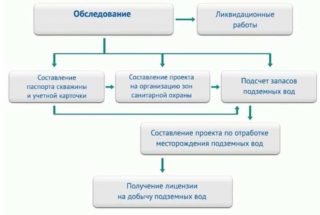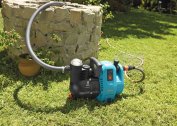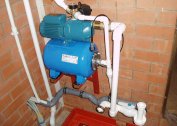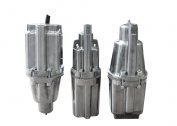Water intake facilities from underground sources are being built in suburban homes and farmlands to establish an autonomous water supply network. Water wells do not belong to the group of hydraulic structures of the first rise. This design is equipped with special pumping stations or a water pump for lifting groundwater to the surface.
Purpose and design of a water well
A water well is a special hydraulic structure designed to take groundwater from the thickness of an aquifer. It is a pipe with a pump, the latter is necessary to maintain the pressure of the water column.
The water intake includes such parts:
- Column or casing - sinks into the bowels of the earth, it may be characterized by a different diameter, length and material of manufacture. The most popular pipes are polyethylene, concrete and steel.
- The filter is designed to clean the liquid from impurities from the soil.
- Water pump. There are several types of equipment and various modifications. Depending on the depth of the well, its diameter, a submersible or surface pump equipped with an electric motor is chosen. It is necessary for transporting a water column from a well to a water tap in the house.
- The trunk is located inside the casing, water rises to the surface along it.
Groundwater can be at different depths, as a rule, this parameter ranges from 5-10 meters to 80 or more.
Depending on this indicator, water wells are divided into several types.
Types of water intake facilities
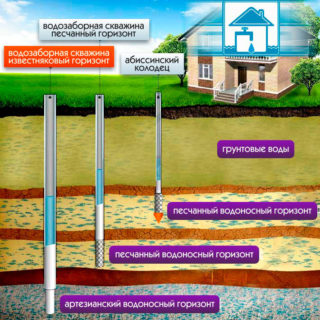 Given the hydrogeological features of the terrain and the technical characteristics of the wells, they are classified as follows:
Given the hydrogeological features of the terrain and the technical characteristics of the wells, they are classified as follows:
- Abyssinian well has a depth ranging from 10-12 meters. These are the smallest indicators among all varieties of sources. For arrangement, the trunk and casing are not used; a “needle” is enough - pipes with a diameter of 70 mm. If the soil layers are soft, there is no need for drilling, it is enough just to hammer it into the ground. The process cannot be called laborious, it does not take much time, effort and finance. A tangible drawback of such a source is the dubious quality of water. Sometimes it is completely unsuitable for drinking. The debit is 0.5 cubic meters / hour, this is enough for a country house and a garden house with inconsistent living. The service life reaches 10 years, but more often the resource is exhausted after 3-5 years.
- Well on the sand. The depth of groundwater can reach 30 meters. Consists of a string or casing with a diameter of up to 130 mm. Drilling such a source requires special equipment and tools. Drilling can take more than one day, investments are also required considerable. The capacity or debit of the source reaches 1.5 cubic meters / hour. The approximate operational life is 15 years.
- The artesian well is characterized by great depth, which reaches 100 or more meters. Water from such a source is considered to be of the highest quality and cleanest, since groundwater no longer penetrates into it. The diameter of the casing or pipe reaches 160 mm. The initial performance indicators are 3 cubic meters / hour, therefore, water distribution can occur simultaneously on several taps. The service life is more than 50 years, but the construction and construction of an artesian well requires large financial investments.
Each type of water well has its own characteristics, having familiarized themselves with them, they select the suitable option for a personal plot.
Normative and technical documents and design stages
If the depth of the waterworks is more than 50 meters, a license is required. These processes are handled by special commissions, which need to submit a full package of documents. As a rule, this is a laborious and lengthy process. Obtaining a certificate can take from six months to a year.
To apply for a license, proceed as follows:
- At the initial stage, a work permit is drawn up to ensure an autonomous water supply system. It is important that you follow the instructions in the document.
- Obligatory registration is subject to ongoing drilling and construction work.
- After familiarization with the stock material, the homeowner receives the terms of reference for the work.
- The next step is the design work for the search and study of the contents of the subsoil.
- Preliminary, the project is undergoing geological examination.
- The design documentation is agreed with the relevant authorities.
- Begin to perform the work described in the project.
- Masters conduct experimental filtering surveys.
- An analysis of the stocks of water and its quality is carried out. Additionally, studies are conducted on radioactivity.
- Information is collected about the well: depth and diameter, dynamic and static water level, debit of the structure. An aquifer stock assessment report is compiled.
- A draft of sanitary protection zones is being prepared.
- Sanitary and epidemiological conclusion.
After completing all of the above documentation and conducting work, you can obtain a license and register the source.
Sanitary protection zone of a water supply source
Each water intake facility has three zones of sanitary protection zones. Thanks to them, it is possible to prevent the ingress of various kinds of contaminants and pathogens into the water. Features and characteristics of each of the belts:
- The first security zone has a radius of 15-60 meters. This circle should be fenced. Construction of facilities is prohibited here, with the exception of those necessary for the operation of a water well.
- The main objective of the second security zone is to protect well water from bacteriological contamination. It is forbidden to erect objects that may carry a potential threat. We are talking about all local treatment facilities, for example, septic tanks, dung and cesspools. The radius of the ring is calculated by a special formula and depends on several factors - the depth of groundwater and the terrain.
- The third security zone is designed to protect the source from chemical pollution. It is strictly forbidden to build fertilizer storages, pesticides and fuels and lubricants in the radius of this ring. The radius is also calculated by a special formula.
At the stage of designing, constructing and equipping a well, it is better to give preference to construction companies with experience in this field.

